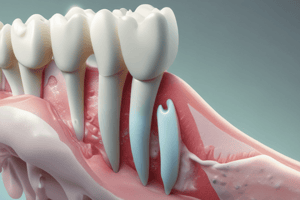Podcast
Questions and Answers
What are the four phases of the test program for evaluating the biocompatibility of biomaterials in dentistry?
What are the four phases of the test program for evaluating the biocompatibility of biomaterials in dentistry?
General toxicity, local tissue irritation, pre-clinical, and clinical evaluation
Why is it important to understand the advantages and limitations of different types of screening assays for biocompatibility evaluation?
Why is it important to understand the advantages and limitations of different types of screening assays for biocompatibility evaluation?
To select appropriate assays and interpret results accurately
What are some of the new scientific advances mentioned in the text that relate to dental materials and therapies?
What are some of the new scientific advances mentioned in the text that relate to dental materials and therapies?
Tissue engineering, stem cell therapy, genetic transfer, biomaterials, and growth factor therapies
What is the primary goal of conducting a structured biocompatibility assessment for new dental therapies?
What is the primary goal of conducting a structured biocompatibility assessment for new dental therapies?
Why is it necessary to prove the safety of new technologies in dentistry before their clinical use?
Why is it necessary to prove the safety of new technologies in dentistry before their clinical use?
What is the overarching objective of using screening assays in the biocompatibility evaluation of dental biomaterials?
What is the overarching objective of using screening assays in the biocompatibility evaluation of dental biomaterials?
How many phases are involved in the structured biocompatibility assessment outlined for evaluating new dental therapies?
How many phases are involved in the structured biocompatibility assessment outlined for evaluating new dental therapies?
What is the minimum success rate required for a restorative material to be approved for commercial sale in the United States?
What is the minimum success rate required for a restorative material to be approved for commercial sale in the United States?
Which criteria are used to evaluate the success of restored teeth during clinical testing?
Which criteria are used to evaluate the success of restored teeth during clinical testing?
What is a requirement for conducting clinical testing of restorative materials?
What is a requirement for conducting clinical testing of restorative materials?
How long must restorations be monitored during clinical testing according to the guidelines mentioned in the text?
How long must restorations be monitored during clinical testing according to the guidelines mentioned in the text?
What is a limitation of the USPHS criteria mentioned in the text?
What is a limitation of the USPHS criteria mentioned in the text?
What is a requirement for the examiners evaluating restorations using the USPHS criteria?
What is a requirement for the examiners evaluating restorations using the USPHS criteria?
What is the range of scores used to evaluate the parameters in the grading system?
What is the range of scores used to evaluate the parameters in the grading system?
What does the text suggest is the reason for the disparity between the estimated failure rate according to USPHS evaluations and the actual surveys of restoration failure and replacement?
What does the text suggest is the reason for the disparity between the estimated failure rate according to USPHS evaluations and the actual surveys of restoration failure and replacement?
What does the text suggest about using the USPHS evaluation system as a continuum to judge longevity or failure of restorations?
What does the text suggest about using the USPHS evaluation system as a continuum to judge longevity or failure of restorations?
What is the purpose of the grading system described in the text?
What is the purpose of the grading system described in the text?




